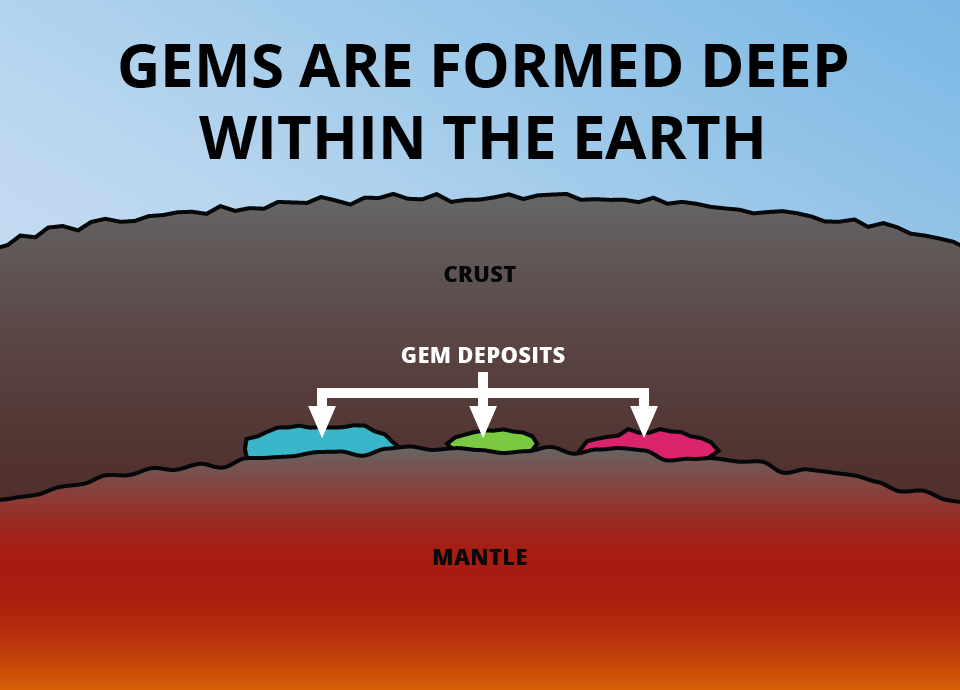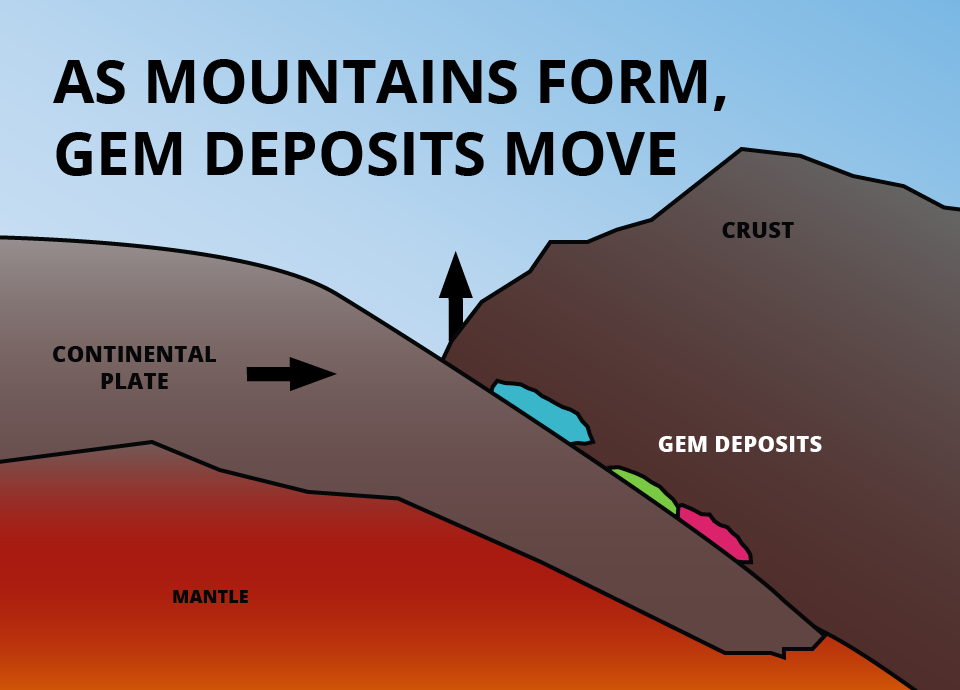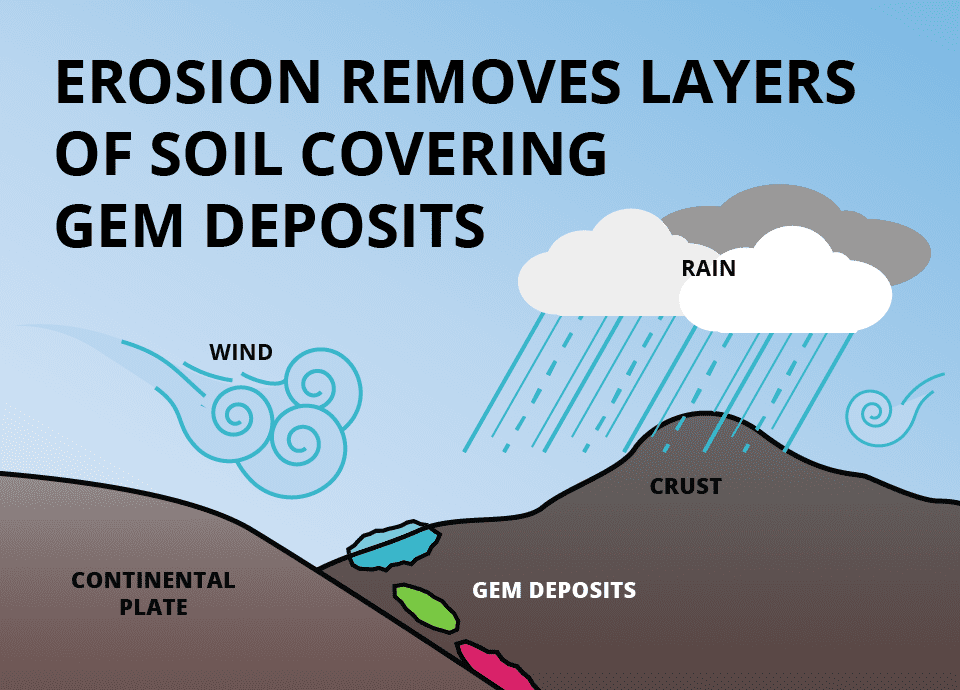How are Gemstones Created?
Gem formation usually involves mineral crystallization and other geological processes. Learn how these affect the gemstone properties gemologists study.
By Donald Clark, CSM IMG, International Gem Society
Most gems form naturally as minerals within the Earth. Most form as crystals, solids whose atoms are arranged in highly ordered repeating patterns called crystal systems. Learning about mineral crystallization and the geological processes involved in gem formation will help gemologists understand some of the properties they’ll encounter in gemstones.
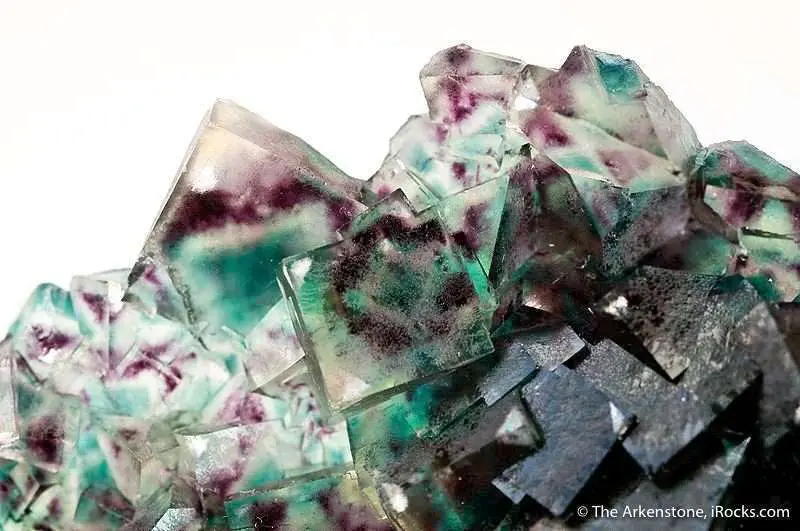
[*Inter-grown, rich green fluorite crystals with lavender color zoning causing by internal phantoms. 13.6 x 11.6 x 2.7 cm. Okorusu Mine, Otjiwarongo Region, Karibib District, Namibia. © Rob Lavinsky, www.iRocks.com. Used with permission.]
Mineral Crystallization: The Basics
This simple exercise actually introduces you to four of the five requirements for mineral crystallization to occur.
Inside the Earth, the ingredients of crystals are more complex and numerous than our sugar solution. Solutions may contain many different minerals.
At a high enough temperature, a solution can hold many minerals in suspension. As the temperature drops, the amount of solid ingredients it can hold in suspension drops as well. When that occurs, crystals form. In fact, different minerals in the same solution will crystallize at different temperatures. For example, corundum might crystallize first. As the solution continues to cool, topaz might form next, then quartz.
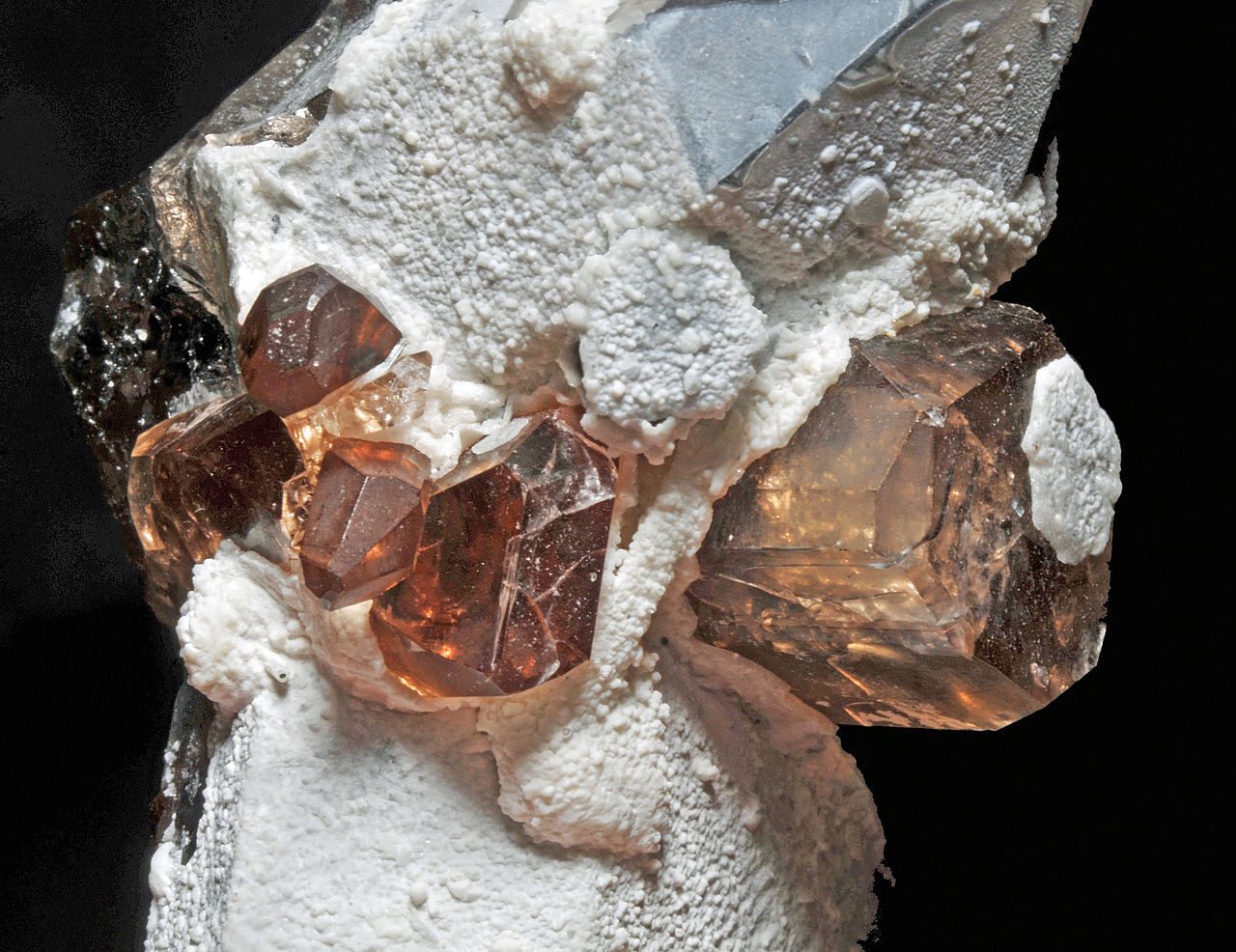
[*The brown topaz crystals shown here would have formed before the smoky quartz crystals during the cooling process. Specimen from Chamachhu, Haramosh Mountains, Skardu, Baltistan, Pakistan. Photo by Géry Parent. Licensed under CC By-SA 3.0.]
Pressure has no effect on the formation of rock candy. However, it takes the proper combination of pressure and temperature for minerals to crystallize. The gems that crystallize underground typically require very high pressures and temperatures.
Time and space are fairly straightforward requirements. The right combination of ingredients, heat, and pressure must last long enough for the minerals to crystallize. They also need room to grow. Obviously, you can’t grow a crystal 3 cm long in a cavity only 3 mm long.
The Underground Environment
Let’s take a look at the conditions that exist underground that make crystallization and gem formation possible.
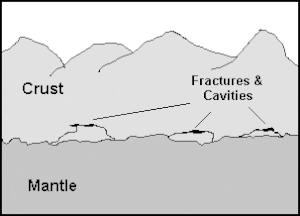
The Earth’s crust varies from 3 miles (around 4.8 km) thick under the seabed to 25 miles (around 40 km) under continents. Under the crust lies the mantle, approximately 1,860 miles (around 2993 km) thick. The mantle makes up 83% of the Earth’s volume. It’s composed of molten rock called magma. In the rare occasions where it reaches the surface, we call it lava. The mantle is hottest near the center of the Earth, and heat currents keep it in constant motion.
The crust and mantle meet in a tumultuous zone with high pressures and temperatures. Several plates make up the crust and float on the liquid mantle. As they run into each other, some are pushed down while others are raised into mountains. The magma is also in constant motion. Its movement and pressure constantly act on the bottom of the crust, creating wear and fracturing. As a result, rocks break free from the crust and are carried away in the fluid magma. Much of this rock material melts, changing the chemistry of the nearby magma. Some of the smaller particles are destined to be inclusions in future gems.
Heavily fractured, the lower surface of the crust contains numerous cavities. Fluids escaping from the magma flow through these fractures and cavities. Here, we find the proper conditions for crystal growth. Chemical-rich fluids supply the necessary ingredients. The cavities offer space to grow. The temperature and pressure here are high. As the fluid moves through the crust, it cools enough for crystallization to occur. The only requirement left is time.
How Interruptions to Crystal Growth Affect Gem Formation
You might think that, in geological terms, time would be more than sufficient for crystal formation. However, in this highly tumultuous environment, passages constantly open and collapse. Often, crystals start to form, then the passage feeding the mineral-rich fluid to the cavity closes. At this point, all growth stops.
If the passage reopens, growth will resume. In most cases, this on-and-off growth pattern is undetectable in a crystal. However, in some cases, it has noticeable effects.
Color Zoning
Sometimes, the successive layers of growth will have slightly different chemical compositions. When this happens, you may see color zoning in the crystal.
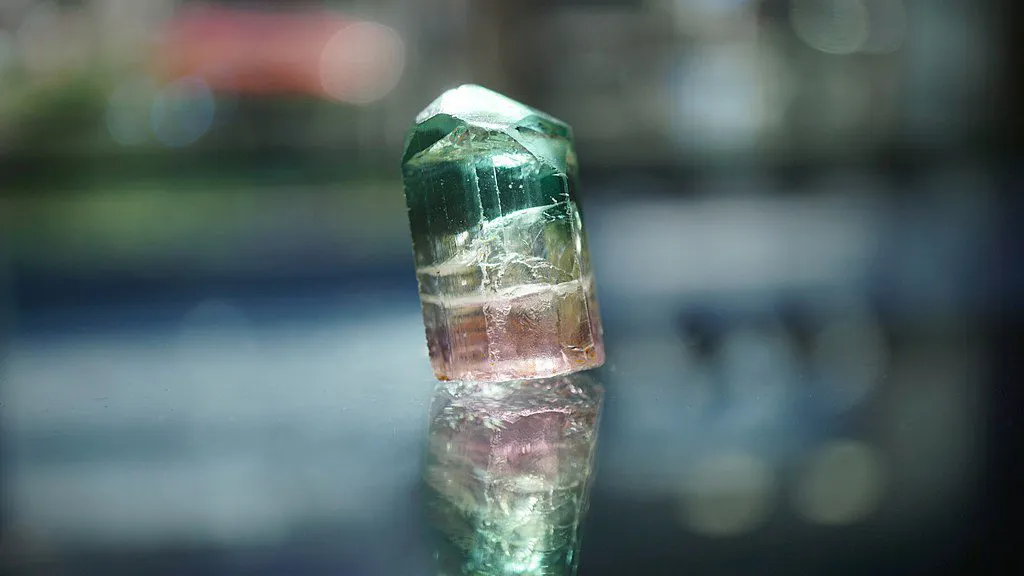
[*Rough bi-colored “watermelon tourmaline” crystal. Photo by Paweł Maliszczak. Licensed under CC By-SA 4.0.]
Twinning
Occasionally, the new layers will have different orientation. This causes twinning.

[*Twinned titanite (sphene) crystal. 2.4 x 1.3 x 1.0 cm. Auraghuq, near Firgamu, Badakshan Province, Afghanistan. © Rob Lavinsky, www.iRocks.com. Used with permission.]
Parting
In some crystals with twinning, the new layers don’t bond completely with each other. When you see parting on a star ruby, for example, the layers didn’t bond.
Crystal Specimens Composed of Different Minerals
Even if a closed passage reopens and fluid again enters a cavity, a totally different mineral may crystallize over the existing material. Indeed, temperature, pressure, and the chemistry of the fluid solution often vary over time. Different conditions will produce different mineral crystals within a cavity. When opening a deposit, you’ll commonly see different minerals covering earlier layers.
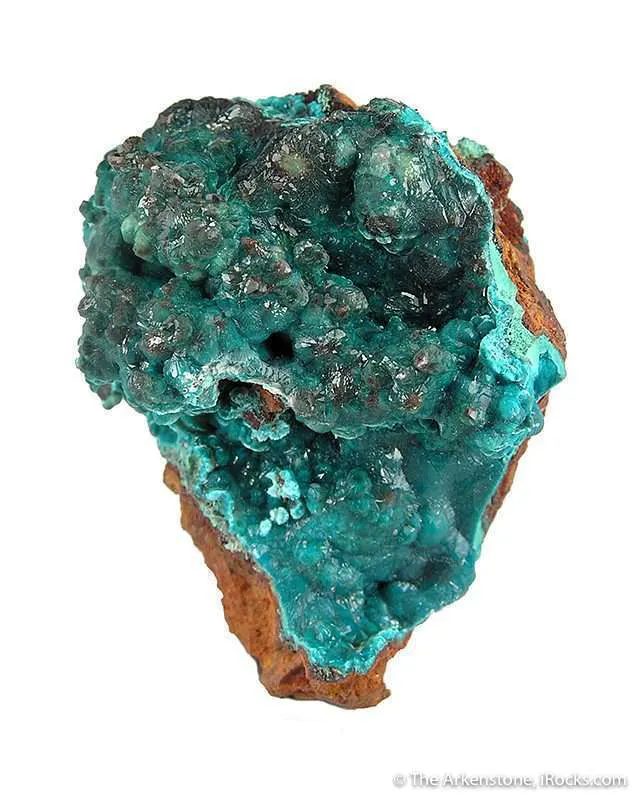
[*This crystal specimen began as a botryoidal crust of malachite on limonite. Later, teal rosasite crystals grew over the malachite. Later still, clusters of small hemimorphite crystals grew on the rosasite. 6.5 x 4.8 x 3.9 cm. Ojuela Mine, Mapimi, Durango, Mexico. © Rob Lavinsky, www.iRocks.com. Used with permission.]
Inclusions
Such changes of conditions within a cavity is also one cause of gemstone inclusions. A new crystal may start to grow on an older and larger one, only to have its growth process stop. If conditions that allow the original crystal to grow resume, the older crystal will grow over the newer one.
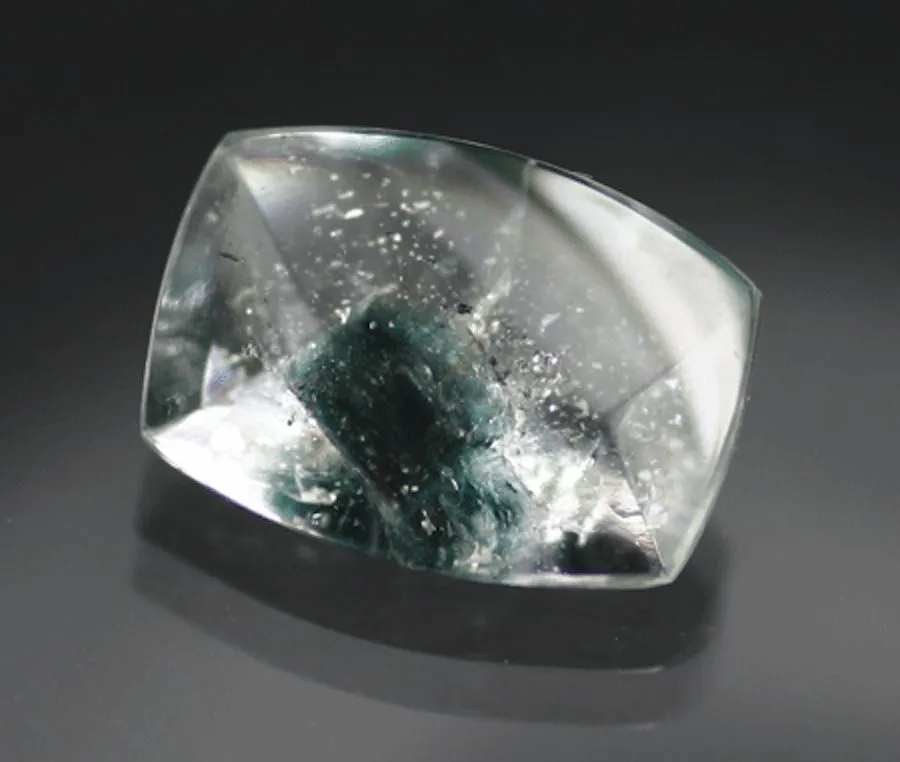
[*This 6.08-ct cushion-cut quartz contains a large, single apatite crystal inclusion. © The Gem Trader. Used with permission.]
Sometimes, two different minerals will crystallize at the same time. If one takes off and starts growing faster, it will engulf the other. This is how pyrite crystals end up inside emeralds.
In still other conditions, chemical impurities can exist within a crystal. If the temperature and/or pressure changes, the impurities can crystallize within the host crystal itself. (In effect, the host crystal acts as a cavity holding ingredients that just need the right conditions to crystallize themselves). This is how rutile forms inside quartz and corundum.
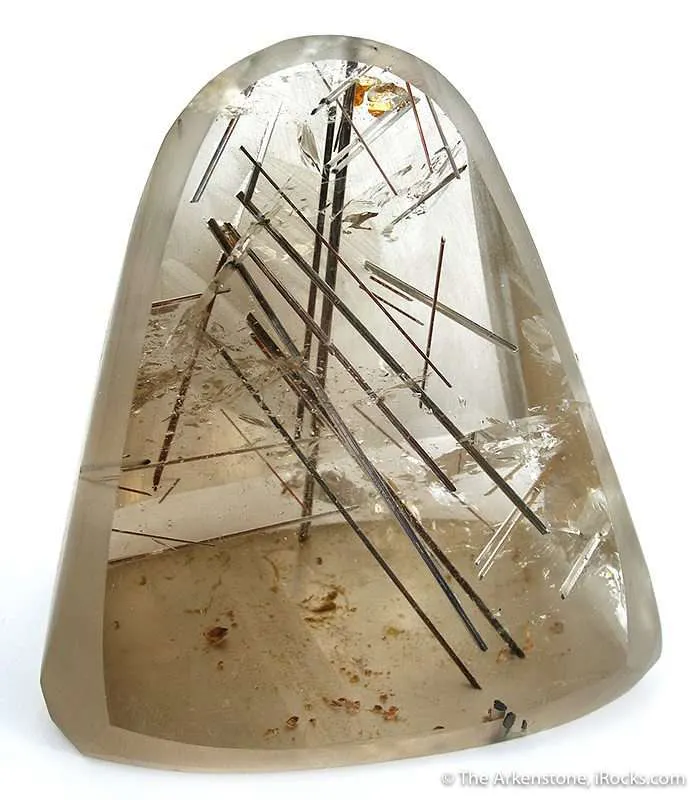
[*This rutilated quartz crystal contains well-formed needle-like crystals of rutile. 5.8 x 5.2 x 2.7 cm. Minas Gerais, Brazil. © Rob Lavinsky, www.iRocks.com. Used with permission.]
Phantoms
In some rare situations, phantom crystals or inclusions may occur. This happens when a new layer of crystals grows over a transparent crystal. For example, a fine layer of feldspar may cover a quartz crystal. Subsequently, conditions change again and the growth of the original transparent crystal resumes. This time, a new layer of quartz covers the feldspar. The resulting gemstone shows the outline of that fine secondary crystal layer as an indistinct form, like a nearly transparent ghost or phantom, hence the name.
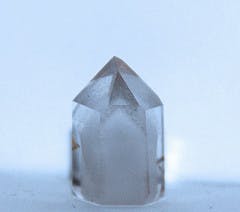
[*A phantom crystal within a crystal.]
Healing Fractures
During the rough and dramatic changes in the crust, many crystals are broken. However, if the conditions for growth are present, material can seep into the fractures and crystallize. In effect, this “heals” the fracture by growing the crystal back together. However, these breaks never heal completely. Fine cavities, filled with gas, remain in the previous gap. We call this type of inclusion a healing fracture. The fine cavities that remain may resemble fingerprints, so gemologists also refer to these inclusions as “fingerprints.”
Strain
The tremendous pressures in the underground environment of gem formation compress many crystals beyond their natural size. This strain can also make a stone prone to breakage. Tourmalines, garnets, and even diamonds may have this level of strain. Many faceters have placed these stones on a lap, only to have them shatter. The forces inside the stone literally cause it to explode.
Geological Processes and Gem Formation
Gemologists now understand mineral crystallization fairly well. Advances in geology as well as synthetic gem manufacturing have unraveled some of these mysteries of nature. (Creating gems in laboratories involves mimicking conditions that exist underground, only vastly reducing the time required).
Traditionally, we were taught that there are three kinds of rock formation processes:
Igneous rocks are created with heat, deep within the Earth.
Metamorphic rocks form when heat and pressure conditions change existing minerals into something new.
Sedimentary rocks form from deposits of sediment.
Today, geologists prefer to describe rock formation as involving four processes:
Molten rock and associated fluids
Environmental changes
Surface water
Gem formation in the Earth’s mantle
We will examine how each of these processes affects gem formation.
Our knowledge notwithstanding, mineral and gem formation are neither simple nor straightforward. Minerals and gems are continuously being destroyed and recreated in the “Rock Cycle,” depicted in the chart below.
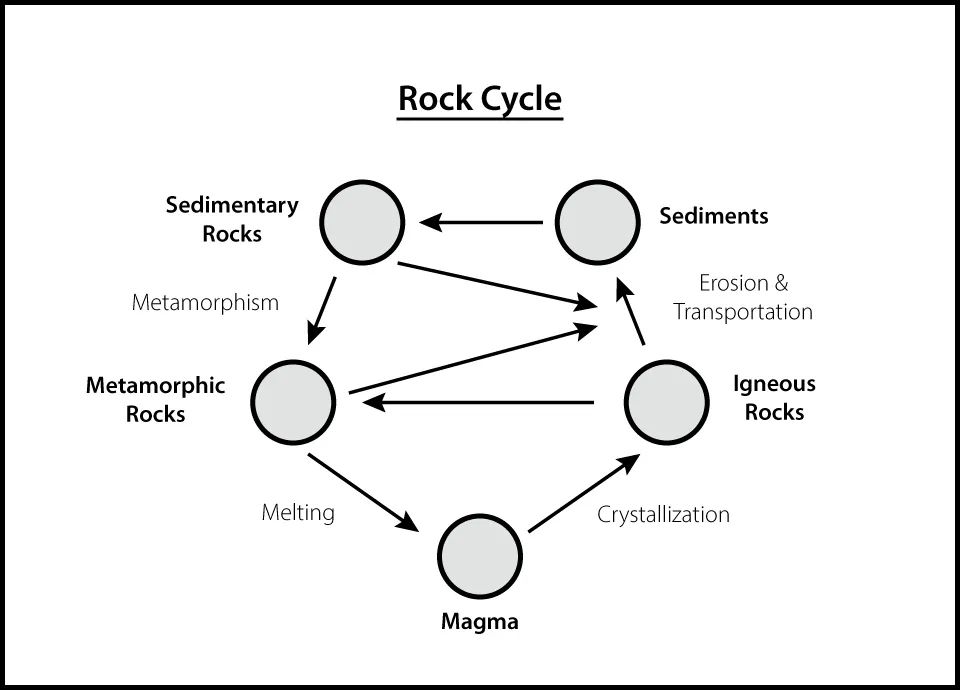
Molten Rock and Associated Fluids
Technically, gems rarely form in the Earth’s magma itself. Rather, they form from fluids that escape from it, such as gems from hydrothermal deposits and pegmatites. First, we’ll cover two exceptions to this process: magma and gas crystallization.
Magma Crystallization
Magma contains a variety of elements. As it cools, the elements combine to form minerals. Exactly what mineral varies with the available ingredients, temperature, and pressure. Each time one mineral forms, the available ingredients change (since some ingredients are pulled into crystals). As magma goes through various stages of changing temperature, pressure, and chemistry, different minerals form.
Aggregates
However, unless the conditions are just right, crystals won’t form. Instead, magma will simply cool into a solid mass of small, interlocking crystals — what gemologists call an aggregate.
Phenocrysts
In some cases, one mineral will crystallize nicely. Then, before any more crystals can form, the magma will find a break in the crust and rush towards the surface. Here, the pressure and temperature are too low to allow crystallization. Instead, the rest of the magma cools into fine-grained rocks, with the original crystals distributed throughout the interior. These are called phenocrysts.
Corundum, moonstone, garnet, and zircon are often found as phenocrysts. The Chanthaburi and Trat districts in Thailand have large deposits of ruby and sapphire phenocrysts.
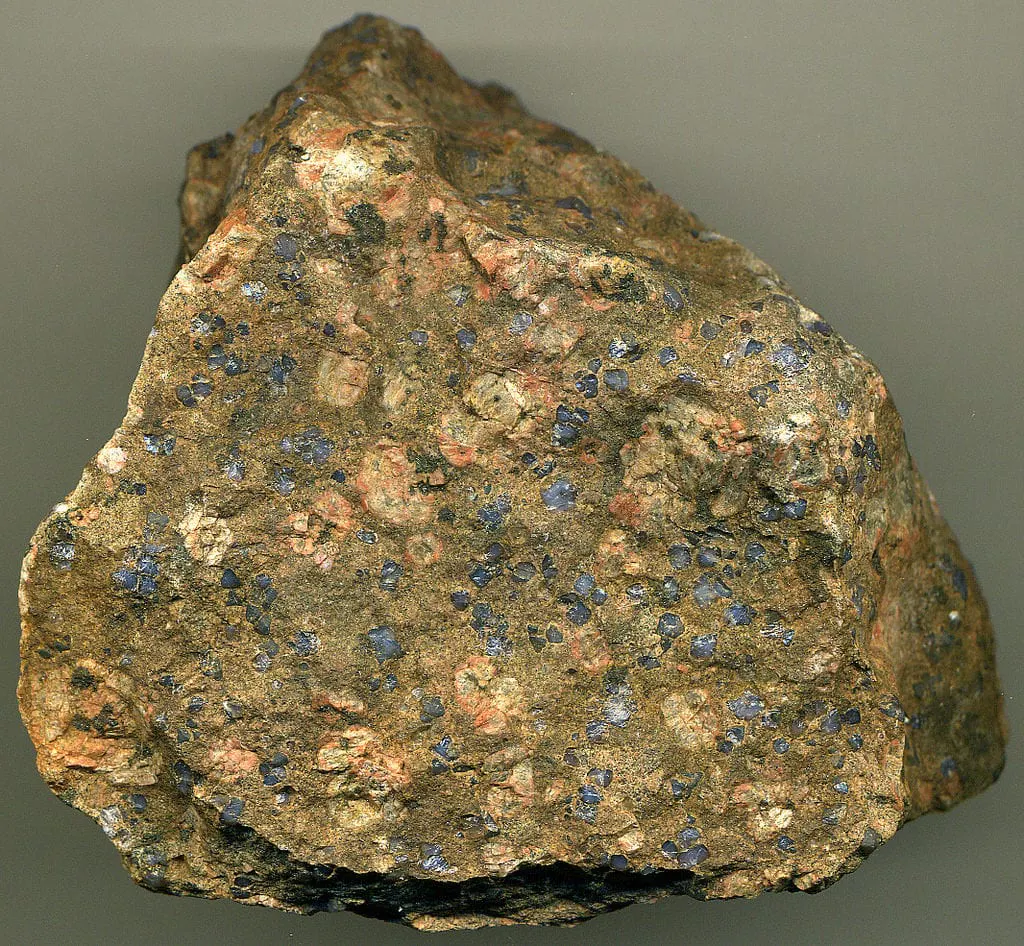
[*Llanite with phenocrysts of orangish perthite and rare dark bluish quartz. Photo by James St. John. Licensed under CC By 2.0.]
Diamond Crystallization
Diamonds crystallize at temperatures higher than other minerals. Scientists now believe that most diamonds may form in the magma, near the Earth’s crust where it’s the coolest. If true, this also means that conditions for diamond crystallization are the most common underground. Diamonds may actually be the most plentiful crystals in the Earth. They just aren’t the easiest to reach. (We’ll discuss diamond gem formation in more depth later in this article).
Gas Crystallization
Have you ever wondered why some crystals are doubly terminated, while most are broken off at the base? Most crystals grow on a solid base of other minerals. However, a few actually grow inside gas bubbles! These gems form after the magma has reached the surface. During a volcanic eruption, rising magma undergoes a rapid reduction in pressure. This causes gas bubbles to form — just like removing the cork from a bottle of champagne.
Sometimes, these bubbles will contain high concentrations of certain elements. If the right combination of temperature and pressure exists for a long enough time, doubly terminated crystals form.
Some of the best known examples of gas crystallization are so-called “Herkimer diamonds.” These quartz crystals get the first half of their nickname from their source, Herkimer, NY. For some gem enthusiasts, the water-clear clarity and shape of these gems evoke the look of diamonds, hence the second half of their nickname. (Of course, quartz gems aren’t diamonds).
Garnet, topaz, and spinel may also form via gas crystallization.
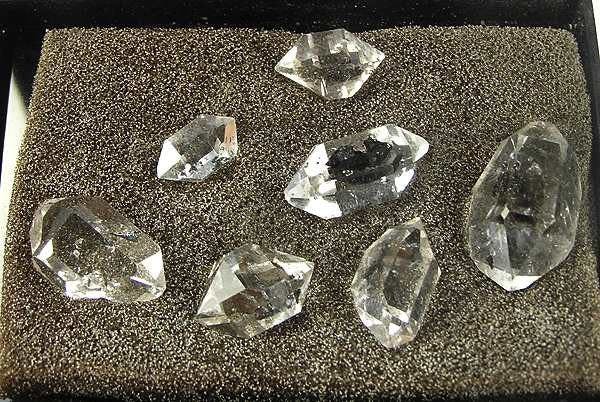
Terminations are flat surfaces or faces at the ends of crystals. Crystals with terminations on just one end are called singly terminated.
[*The other end is either attached to a matrix or lacks faces. Crystals with terminations at both ends, like those shown here, are called doubly terminated. Set of 7 “Herkimer diamonds” (quartz). Herkimer Co., New York, USA. © Rob Lavinsky, www.iRocks.com. Used with permission.]
Hydrothermal Deposits
As the name implies, hydrothermal crystallization involves water and heat. As water percolates through the Earth, it dissolves minerals. (Just as it did with the sugar in your rock candy). Deep inside the Earth, it meets with magma. Special fluids then escape from the magma that contain water, carbon dioxide, and volatiles (substances that give off gas).
These hydrothermal fluids move through fractures in the crust. Along the way, they may dissolve minerals or combine with other groundwaters. These mineral-rich fluids begin to cool in “veins.” With the right combination of temperature, pressure, time, and space, crystals form.
Hydrothermal deposits are special because they can have combinations of elements not found elsewhere. One of the most important hydrothermal deposits of gemstones is the Muzo emerald field in Colombia.
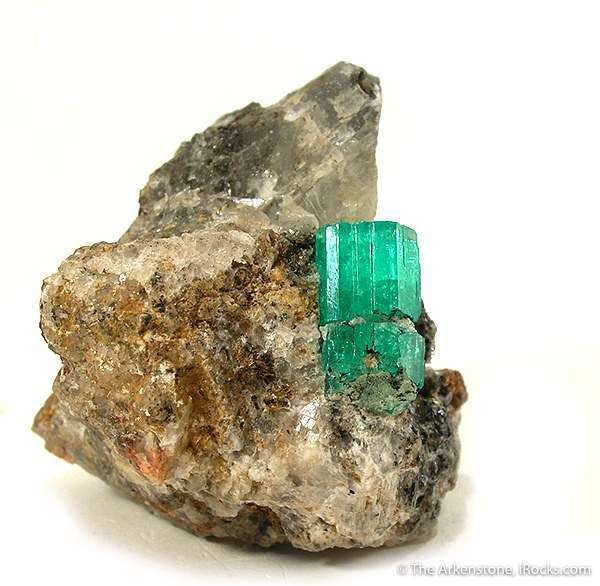
[*Emerald crystal, about 2 cm in length. Muzo Mine, Boyaca Dept., Colombia. © Rob Lavinsky, www.iRocks.com. Used with permission.]
Pegmatites
Magma in the upper part of the mantle sometimes becomes concentrated with volatiles. This volatile-rich magma is sometimes forced into a cavity where it cools and becomes a pegmatite. Pegmatites differ from hydrothermal veins, since magma acts as the primary agent instead of water.
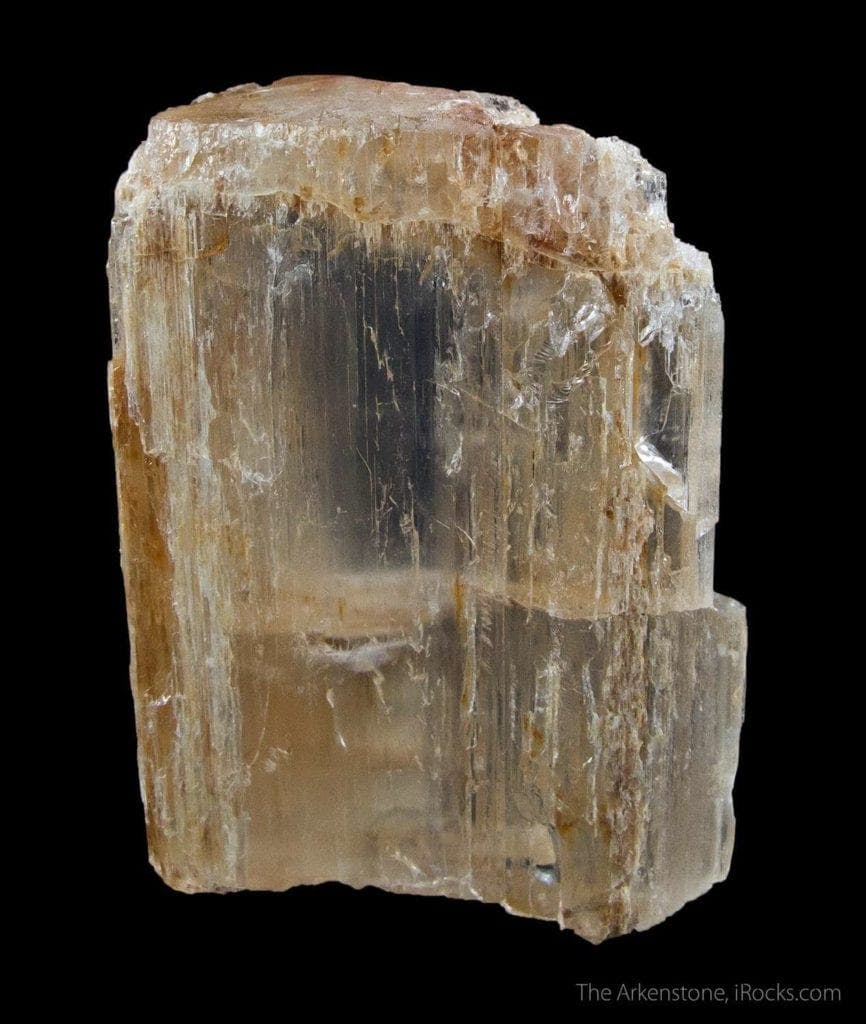
[*Hambergites, like this pinkish tan crystal, can form as pegmatites. 4.4 x 3.2 x 1.9 cm. Malkhan pegmatite field, Chitinskaya Oblast’, Transbaikalia, Eastern Siberian Region, Russia. © Rob Lavinsky, www.iRocks.com. Used with permission.]
Environmental Changes
Great stresses exist inside the Earth. Under the right conditions, temperatures and pressures can rise to the point where existing minerals can’t remain stable. This can cause minerals to change into different species without melting. This is known as metamorphism.
There are two types of metamorphism: contact and regional.
Contact Metamorphism
Contact metamorphism occurs when magma forces its way into an existing rock formation. Under the intense heat, existing rocks begin to melt and eventually recrystallize as new species. These are stable at higher temperatures.
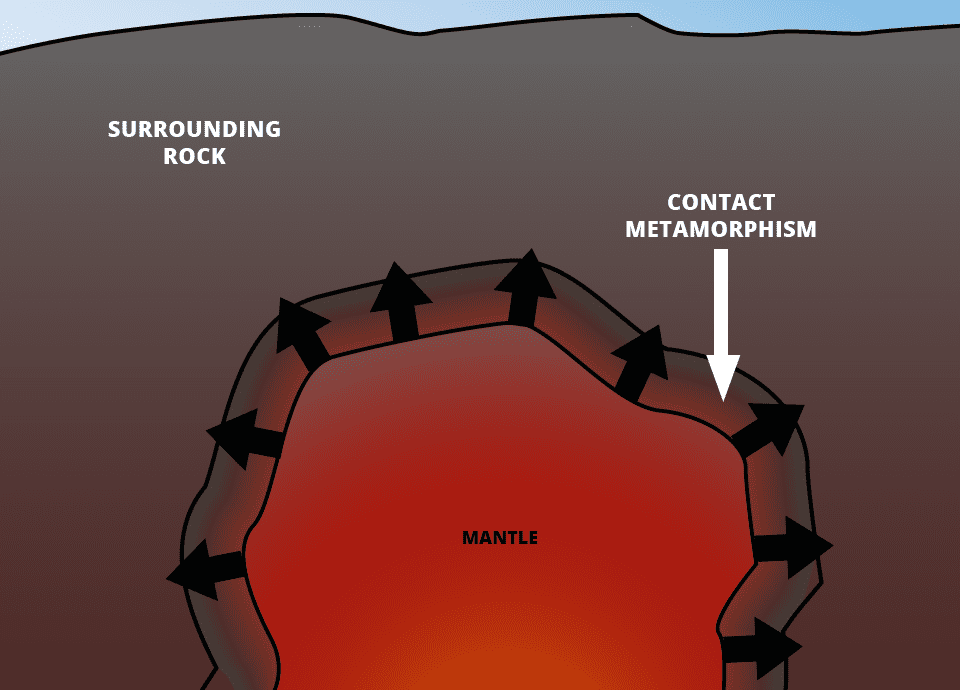
Regional Metamorphism
Regional metamorphism takes place on a much broader scale than contact metamorphism. It affects a much greater variety of minerals.
Large pieces called “continental plates” make up the Earth’s surface. They float on the mantle and, on a geological time scale, they move. However, they don’t all move in the same direction. Some of them even compete for the same space. Where these huge structures are forced together, one is shoved underneath, and the other is pushed up. This is our planet’s primary method for building mountains.
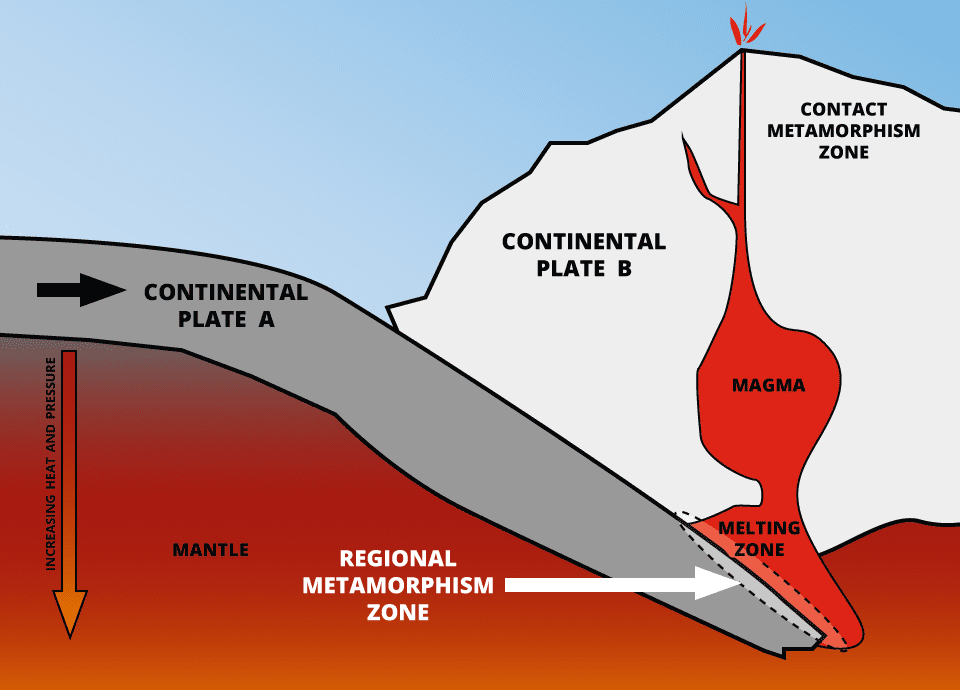
Enormous compression forces exist where these land masses come together. This creates an area of intense heat and pressure. As the temperature approaches the melting point of rock, the minerals in the area become unstable. Over time (possibly millions of years), they change into new species.
East Africa is an excellent example of an area of regional metamorphism. Some minerals found here don’t exist anywhere else, such as tanzanite and commercial-quality tsavorite.
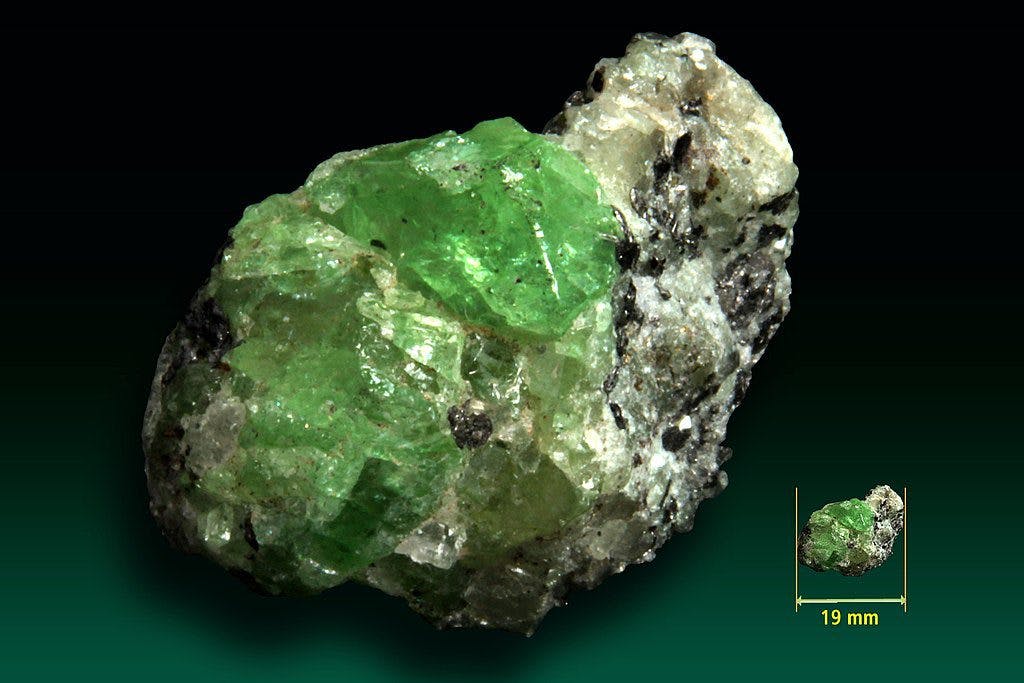
[*Tsavorite garnet, Merelani Hills, Arusha Region, Tanzania. Photo by Lech Darski. Licensed under CC By-SA 4.0.]
How Mineral Species Change
To understand some of the changes that occur to minerals during metamorphism, keep in mind what defines a mineral species: both its chemical formula and crystal structure. Sometimes during metamorphism, a mineral changes one of these properties but not the other. This still constitutes a change in species. Such changes create species known as polymorphs and pseudomorphs.
Polymorphs
Minerals that share the same chemistry but have different crystal structures are called polymorphs. Polymorphous pairs of minerals are sometimes called dimorphs or dimorphous.
For example, andalusite, kyanite, and sillimanite all have the same chemistry, Al2SiO5. During metamorphism, they regularly polymorph into each other when their chemical ingredients recrystallize into new crystal structures. Thus, they change into different, but polymorphous, species.
Pseudomorphs
Minerals that change chemistry without changing their external crystal form are called pseudomorphs.
During metamorphism, some minerals may change chemistry but recrystallize in their customary crystal habits, showing no abnormal properties. However, sometimes a crystal will change chemistry without recrystallizing. These unique minerals are called pseudomorphs. A pseudomorph is an atom-by-atom replacement of one mineral for another without changing the original mineral’s outward shape.
Tiger’s eye is a prime example of a pseudomorph. In these gems, quartz has replaced the original crocidolite (a form of asbestos), but they retain the fibrous structure of crocidolite.
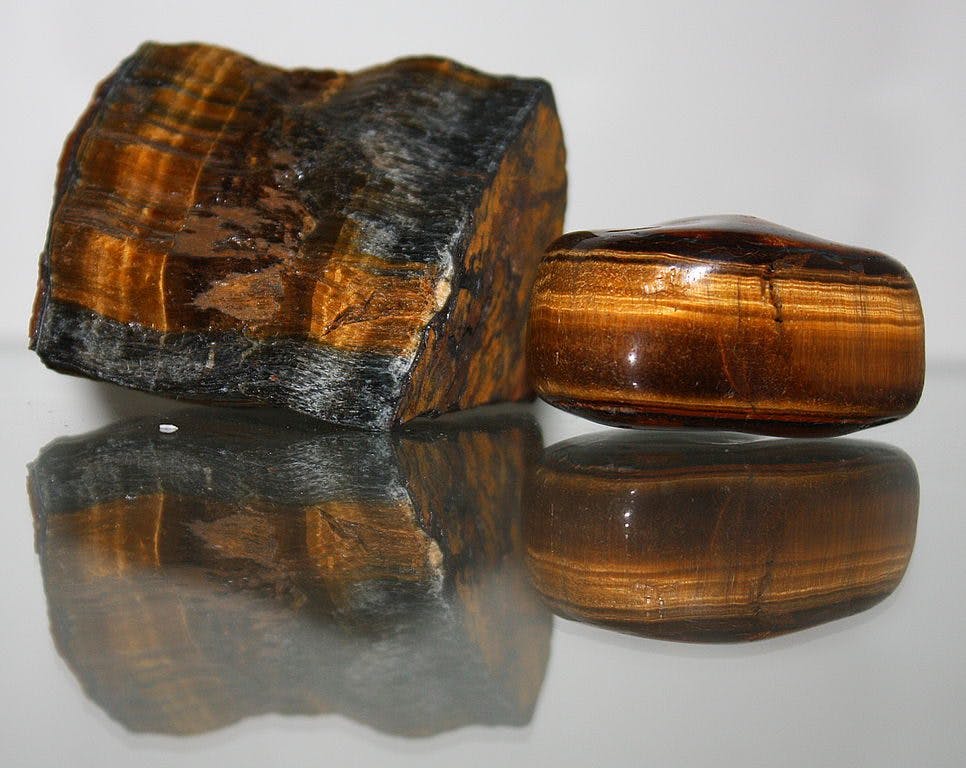
[*Tiger’s eye. Photo by Marek Novotnak. Licensed under CC By-SA 4.0.]
Marcasite can pseudomorph into pyrite, gypsum, fluorite, and goethite.
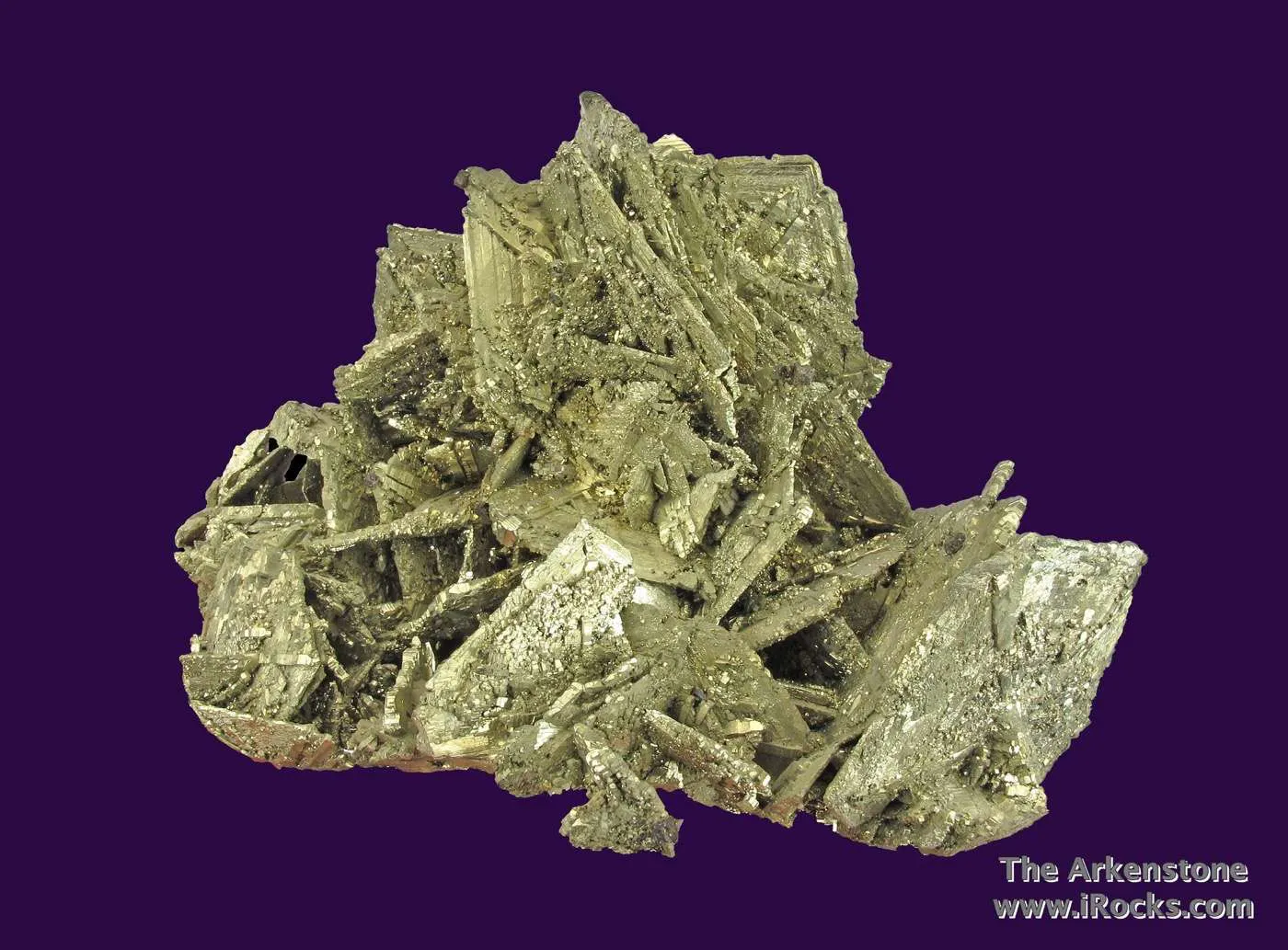
[*Cluster of pyrite blades pseudomorphed after marcasite. 11.5 x 8.0 x 7.2 cm. Nanisivik Mine, Nanisivik, Baffin Island, Nunavut Territory, Canada. © Rob Lavinsky, www.iRocks.com. Used with permission.]
Azurite frequently pseudomorphs into malachite, resulting in a perfect azurite crystal shape composed of malachite.
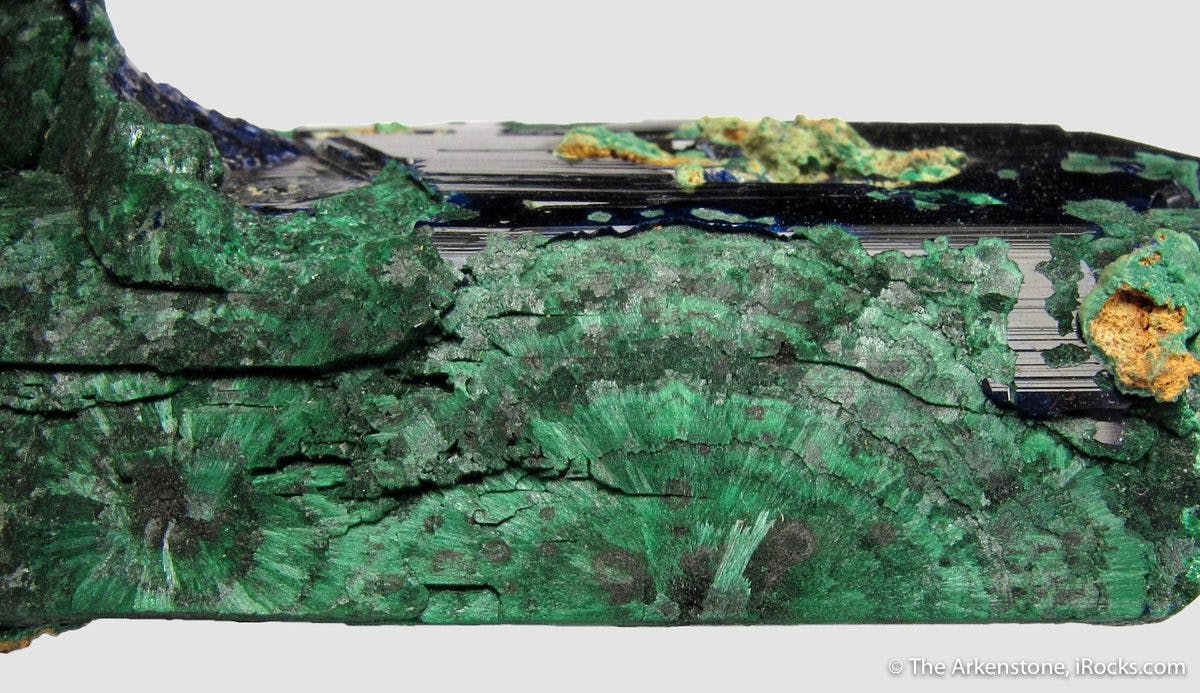
[*An azurite crystal collected partway through the process of altering into malachite. 7.3 x 3.7 x 2.0 cm. Tsumeb Mine, Tsumeb, Otjikoto Region, Namibia. © Rob Lavinsky, www.iRocks.com. Used with permission.]
When a mineral forms as a pseudomorph, it’s described as the new mineral “after” the original. Thus, we might encounter “pyrite after marcasite,” “gypsum after marcasite,” “malachite after azurite,” etc.
Surface Water
Rain plays an important role in recycling minerals. Erosion breaks down rocks and moves them to new locations. Once on the ground, rainwater is instrumental in new gem formation.
Fossil Formation
As water passes through the Earth, it picks up chemicals that turn it into a weak acid. If heated, or mixed with the right chemicals, it can become highly corrosive. This gives water the ability to dissolve even more minerals. As water percolates through the Earth, it also picks up many ingredients. At times, it becomes too saturated to carry any more, so it leaves the excess in cracks and pores of existing rocks. This is how fossils and petrified wood are created.
In other conditions, water encounters combinations of minerals that create a chemical reaction. The dissolved minerals are then deposited as new minerals in seams and cavities. This is how opal, turquoise, azurite, and malachite are created.
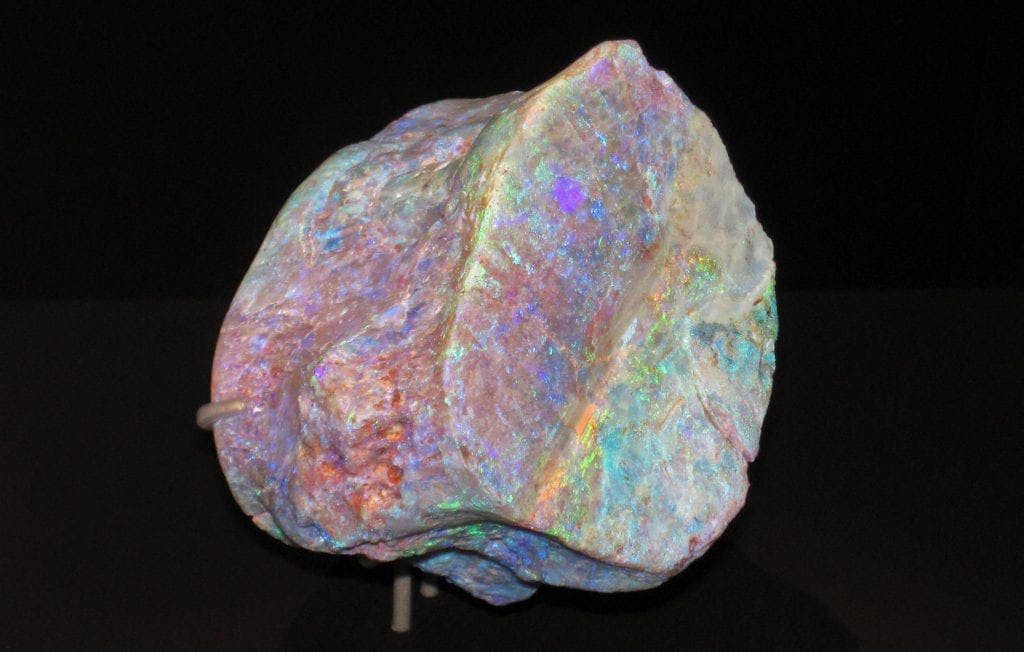
[*On rare occasions, opal can replace the minerals of bones, creating “opalized fossils” like this plesiosaur vertebra found in Australia. Specimen from the collection of the Field Museum of Natural History, Chicago. Photo by James St. John. Licensed under CC By 2.0.]
Opal Formation
During the Cretaceous period, much of central Australia was covered by an inland sea. When it dried, it left the area layered with silica-rich sands. For millions of years, rain has been dissolving the silica. During the hot, dry summers, the ground water evaporates to the point where the remaining water can’t hold the silica in suspension. The excess is deposited in seams and cavities, not far below the surface. These silica deposits are opal.
Waterborne Minerals Can Create Gem Colors
Some gemstones get their color primarily from minerals essential to their chemical composition. For example, turquoise, azurite, and malachite all receive their color from copper brought by water. The copper-rich water must pass through limestone to create azurite or malachite. Turquoise also requires that the water pick up some phosphorous along the way.
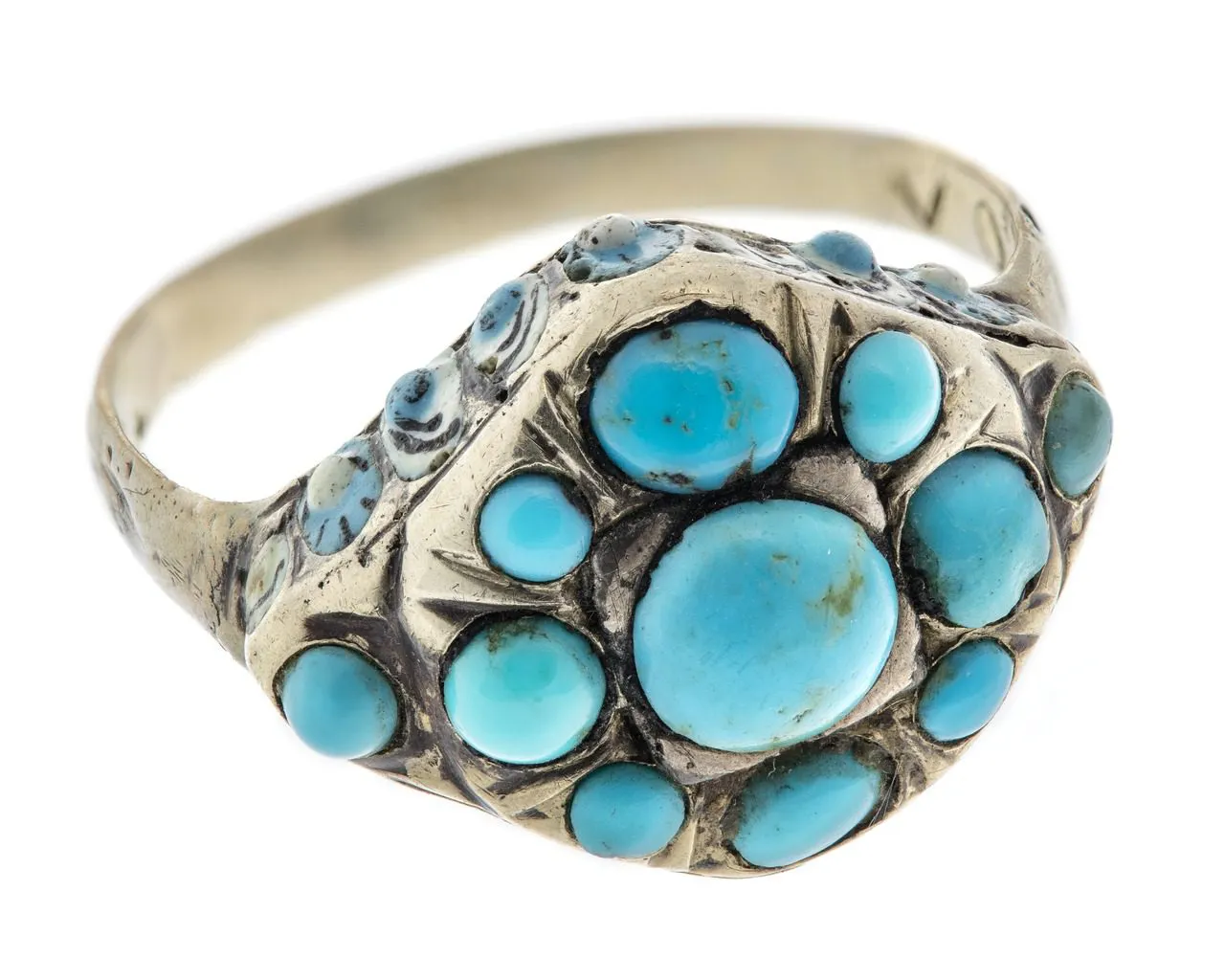
[*Turquoise is an idiochromatic gem. This means it derives its color from essential components of its chemical formula. The combination of copper and phosphorous give turquoise its characteristic blue color. (However, these elements in other gemstones may cause different colors. For example, copper in cuprite creates a red color). Gold and enamel ring with turquoises, probably Italian work from the 18th century. From the collection of the Hallwyl Museum, Stockholm, Sweden. Photo by Helena Bonnevier. Licensed under CC By-SA 3.0.]
Gems Formed in the Earth’s Mantle
Our knowledge of the Earth’s mantle is still rather limited. However, the evidence shows that some gems actually form in the mantle. To do so, they need to crystallize at an extremely high temperature. The most notable examples of gems formed in the Earth’s mantle are diamond and peridot. (Oddly enough, both of these gems can also occur extraterrestrially. Both have been found in meteorites).
Peridot Gem Formation
From studying peridot deposits in Arizona, geologists now believe some peridots were created on rocks floating in the mantle, approximately 20 to 55 miles (approximately 32 to 89 km) below the surface. An explosive eruption brought them near the surface of the Earth. Subsequently, weathering and erosion finally brought them close enough to the surface for people to find them.
Diamond Gem Formation
Diamond formation is better understood. As mentioned before, most diamonds actually crystallize in the magma below the crust. However, the magma formations they’re found in have a different chemical composition. They may come from greater depths, 110 to 150 miles (approximately 177 to 241 km) below the surface. At this depth, the temperatures are higher, and the magma is very fluid.
This hot and fluid magma can force its way through the crust faster and more violently than other volcanic eruptions. During this process, it will break up and dissolve lower mantle rocks and then carry them to the surface.
How Mountain Building and Erosion Bring Gems to the Surface
As we’ve just discussed, a few types of gems come to the surface during volcanic eruptions. However, what about so many others that crystallize far underground? Most of these gems reach the surface through mountain building and erosion. Over vast periods of time, the movement of the continental plates causes mountains to rise. Then, years of weathering take down the mountain, leaving the gem deposits near the surface. Of course, this process takes many millions of years.If the magma rose slower, the diamonds would probably not survive. The changing temperatures and pressure would cause them to vaporize or recrystallize as graphite. The speed of the magma rise may be so quick that the diamonds don’t have time to transform.

[*How diamonds reach the surface. 1. A magma pocket comes in contact with a weak area in the crust. 2. A quick explosion results, carrying diamond-bearing magma to the surface. During the eruption, a cone builds on the surface. 3. The carrot-shaped pipe eventually cools. 4. The cone quickly erodes away (geologically speaking), leaving the diamond-bearing earth where people can reach it.]
How Mountain Building and Erosion Bring Gems to the Surface
As we’ve just discussed, a few types of gems come to the surface during volcanic eruptions. However, what about so many others that crystallize far underground? Most of these gems reach the surface through mountain building and erosion. Over vast periods of time, the movement of the continental plates causes mountains to rise. Then, years of weathering take down the mountain, leaving the gem deposits near the surface. Of course, this process takes many millions of years.
